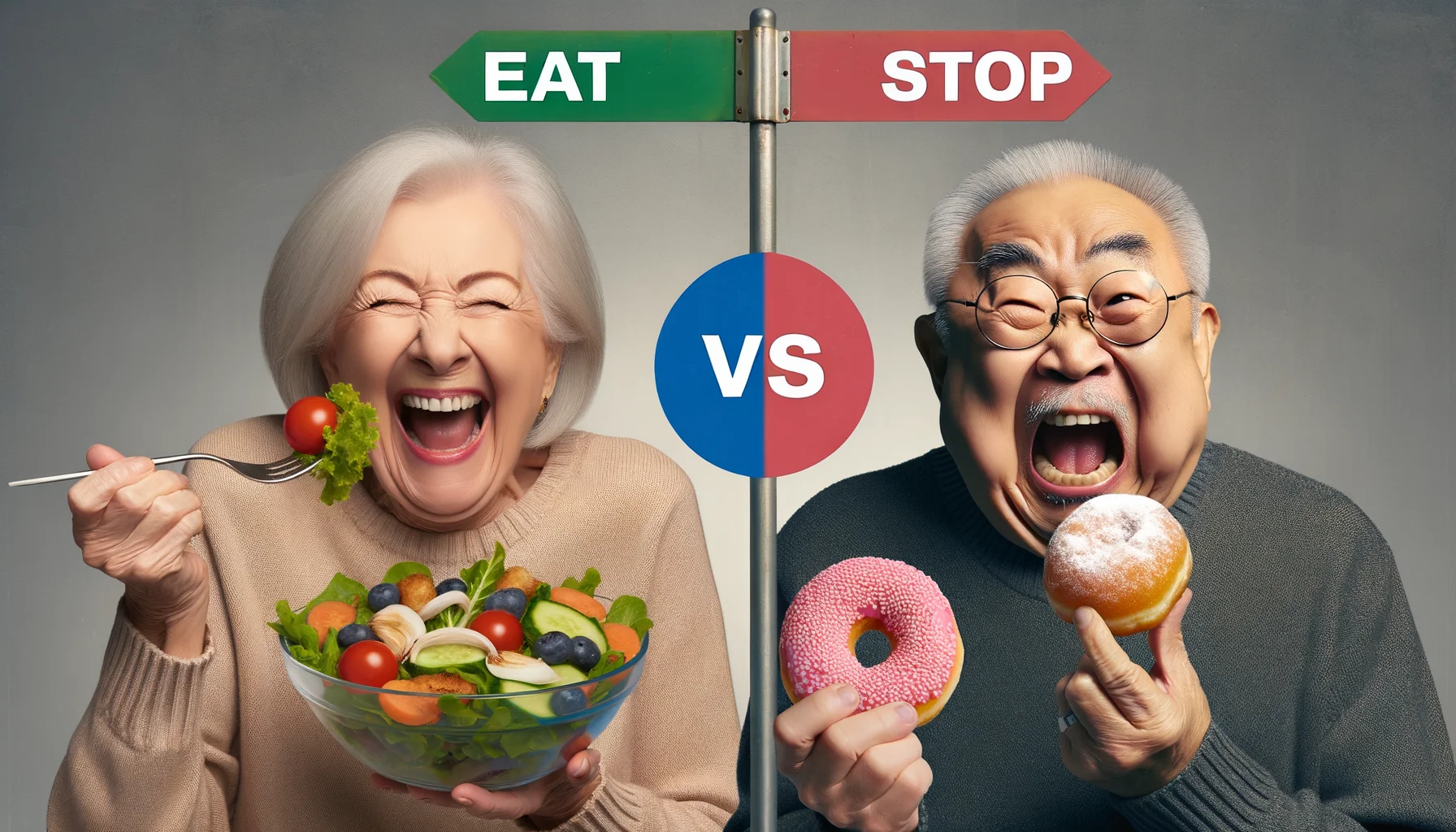Eat stop eat before and after Quiz
Test Your Knowledge
Question of
Understanding Eat Stop Eat
The Basics of Intermittent Fasting
Defining Intermittent Fasting
Intermittent fasting is a revolutionary approach to eating that alternates periods of eating with periods of fasting. It's not about which foods to eat, but rather when you should eat them. This strategy can lead to significant weight loss and may also benefit your metabolism.
The beauty of intermittent fasting lies in its simplicity. There's no need for complicated diet plans or calorie counting. Instead, it offers a flexible schedule that works for many lifestyles, making it an increasingly popular choice among health enthusiasts.
Health Benefits of Fasting
Fasting isn't just about weight loss; it's a catalyst for numerous health benefits. Studies have shown that it can improve blood sugar control, reduce inflammation, and even enhance brain function. It's a powerful tool in the fight against aging and chronic diseases.
Moreover, intermittent fasting has been linked to improved heart health due to its potential to lower blood pressure and cholesterol levels. This dietary approach can be a game-changer for long-term wellness and vitality.
Common Misconceptions
Despite its benefits, intermittent fasting is often misunderstood. A common myth is that it leads to muscle loss; however, evidence suggests that it actually preserves muscle mass while promoting fat loss. It's critical to debunk these myths for a clear understanding of the practice.
Another misconception is that fasting triggers overeating during non-fasting periods. In reality, most people naturally adjust their intake without excessive compensations, maintaining a healthy balance.
How Eat Stop Eat Works
The 24-Hour Fast Protocol
Eat Stop Eat simplifies intermittent fasting with a straightforward 24-hour fast protocol. This involves choosing one or two days per week where you abstain from eating for a full day. During non-fasting days, you return to normal eating habits without restrictions.
This method is incredibly adaptable and can be easily incorporated into any lifestyle. Whether you're a busy professional or a stay-at-home parent, the 24-hour fast offers a manageable approach to reaping the benefits of intermittent fasting.
Metabolic Responses to Fasting
Fasting sets off a fascinating chain reaction in the body. Initially, glycogen stores are depleted, prompting the body to burn fat as fuel. This metabolic shift is key to losing weight effectively while maintaining energy levels.
- Avoiding Overhydration: While staying hydrated is crucial during fasting periods, excessive water intake can lead to electrolyte imbalances.
- Sensible Break-Fast: Your first meal after fasting should be well-balanced and not overly large; overeating can negate the benefits of your fast.
- Maintaining Balance: On non-fasting days, maintain a healthy dietdon't use them as an excuse for uncontrolled eating.
- Listens to Your Body: Pay attention to how your body responds during fasting periods; if you experience adverse effects, consider adjusting your approach or seeking professional guidance.
- Avoiding Intense Workouts: High-intensity exercise on fasting days may be challenging; choose lighter activities like walking or yoga instead.
- Social Eating Planning: Schedule your fasting days around social events where food isn't the focal point to avoid temptations and awkward situations.
- Prioritizing Sleep: Ensure adequate sleep during fasting days as it aids in recovery and helps manage hunger hormones like ghrelin and leptin.
- Incorporating Mindfulness: Use fasting periods as an opportunity for mindfulness practices which can enhance the mental clarity associated with fasting.
Psychological Aspects of Eat Stop Eat
Eat Stop Eat goes beyond physical healthit also promotes psychological well-being. By breaking free from constant meal planning and snacking, individuals often experience a sense of liberation and control over their dietary choices.
Fasting encourages a mindful approach to eating and fosters an awareness of true hunger cues versus habitual eating patterns. This deeper connection with ones body can lead to more mindful food choices and improved overall health.
Preparing for Eat Stop Eat
Setting Realistic Goals
Embarking on the Eat Stop Eat journey calls for a thoughtful assessment of your current health and dietary patterns. Understanding where you're starting from is critical to setting achievable goals. Take stock of your past diet experiences and any health issues that could influence your intermittent fasting plan.
Once you've got a clear picture of your starting point, it's time to craft short and long-term objectives that are both challenging and attainable. Short-term goals keep you motivated day-to-day, while long-term objectives anchor your overall journey. Remember, progress is not always linear, so flexibility is key!
To truly succeed, monitoring your progress is absolutely non-negotiable. Whether it's through journaling, apps, or check-ins with a health professional, tracking your advancement provides invaluable feedback. It's not just about the scale; consider energy levels, mood improvements, and other health markers.
Assessing Your Health and Diet History
Diving into Eat Stop Eat without considering your unique health history is like sailing without a compass! It's imperative to reflect on any medical conditions or dietary restrictions you have. This insight will help tailor the program to fit you perfectlylike a glove!
If you've battled with weight fluctuations or diet regimens in the past, take a moment to analyze what worked and what didn't. Learning from past triumphs and tribulations can dramatically increase your chances of success this time around. Knowledge is power!
Establishing Short and Long-Term Objectives
Short-term goals might include completing a full cycle of Eat Stop Eat without deviations or integrating more whole foods into meals. These immediate targets serve as stepping stones towards grander aspirations such as significant weight loss or improved metabolic health over months or years.
Long-term objectives require patience and perseverance. They should be inspiring yet realistic, such as reaching a specific weight or achieving better blood sugar control. Visualize where you want to be in a year's timethat vision will fuel your commitment each day!
Monitoring Progress Effectively
Keep an eagle eye on your progress but don't be obsessed with daily fluctuations. Focus on trends over weeks and months for a true measure of effectiveness. Use tools that work for yoube they digital apps or good old-fashioned pen and paper.
Acknowledge non-scale victories too! Maybe you've noticed improved sleep quality or higher energy levelsthese are signs of progress that deserve celebration. Celebrate every victory, no matter how small they may seem; they all add up in the grand scheme of things.
Essential Tips Before Starting
Managing Hydration and Electrolytes
Maintaining hydration is paramount when fasting with Eat Stop Eat. Water becomes even more crucial as it aids in hunger management and maintains bodily functions. Don't ignore electrolytes either; sodium, potassium, and magnesium are vital players in keeping hydration in balance.
Preparing Your Pantry for Success
Clean out the junk! Stocking up on nutritious foods that align with the Eat Stop Eat philosophy is essential. Fill your pantry with high-fiber foods, lean proteins, healthy fats, and plenty of greens to ensure you're well-equipped for success.
- Stay Hydrated: Always have water at hand especially during fasting periods.
- Balanced Meals: When not fasting, focus on balanced meals rich in protein, fiber, and healthy fats.
- Avoid Temptation: Remove high-sugar, high-calorie snacks from easy reach to stay on track.
- Mindful Eating: Pay attention to hunger cues during eating windowseat when hungry, stop when full.
- Sleep Well: Prioritize sleep to support metabolic health and recovery.
- Fitness Routine: Incorporate regular physical activity that you enjoyit boosts results and mood!
- Fasting Gradually: Start with shorter fasting periods before diving into longer ones to adapt comfortably.
- Patient Persistence: Trust the process even if results aren't instantaneous; consistency is key!
During the Fast: What to Expect
Physical Changes and Adaptations
Embarking on a fasting journey triggers a cascade of remarkable physical changes. Your body enters a state of ketosis, burning fat for fuel instead of glucose, which can lead to weight loss and improved metabolic health. As glycogen stores deplete, you might experience a temporary dip in energy levels before your body fully adapts to this new fuel source.
Energy Levels and Metabolism : Initially, you may feel a bit sluggish as your body transitions from using readily available glucose to breaking down fat for energy. However, many report a surge in energy and mental clarity once this adaptation occurs. It's essential to listen to your body and adjust your activity levels accordingly during this period.
Hunger Cues and Appetite Management : Hunger pangs are common as your body adjusts to the fasting schedule. Over time, these sensations often diminish as ghrelin, the hunger hormone, stabilizes. Drinking water, staying busy, and ensuring nutrient-dense meals can help manage appetite during fasting windows.
Autophagy and Cellular Repair : One of the most exciting aspects of fasting is autophagy, a process where cells clean out damaged components. This cellular housekeeping is believed to play a role in disease prevention and longevity. As you fast, your cells become more efficient recyclers, removing debris that could otherwise contribute to aging and illness.
Emotional and Mental Well-being
Fasting isn't only about transforming the body; it also has profound effects on your emotional and mental well-being. It can be a period of heightened emotional clarity but also vulnerability as you challenge ingrained eating habits and comfort mechanisms.
Coping with Cravings : Cravings can be intense during a fast but understanding their source is key. Are they physical or emotional? Recognizing the difference helps in addressing them appropriately. Distraction techniques, hydration, or even meditation can serve as effective coping mechanisms.
- Avoid high-stress activities that may intensify cravings.
- Stay hydrated with water or herbal teas to help suppress false hunger.
- Engage in light exercise like walking or yoga to distract the mind.
- Maintain a journal to document cravings patterns and learn from them.
- Plan non-food-related rewards for hitting fasting milestones.
Mindfulness and Emotional Eating : Fasting offers an opportunity to develop mindfulness around food choices and consumption patterns. By observing your reactions to hunger and satiety cues without acting on them impulsively, you cultivate greater discipline and awarenessa skill that benefits all areas of life.
Staying Motivated During the Fast : Staying motivated during a fast requires focus on your goals and recognizing the positive changes occurring within your body. Visualize the success you're working towardswhether it's better health markers, weight loss, or mental sharpnessand let that vision fuel your commitment through challenging moments.
Breaking the Fast: Best Practices
Post-Fast Nutrition Strategies
The transition from fasting to eating is a critical period that demands attention and care. Selecting the right foods to reintroduce to your diet can make all the difference in capitalizing on the benefits of your fast. A gradual approach is key to avoid overwhelming your digestive system.
It's essential to focus on easily digestible foods initially, such as fruits, vegetables, and lean proteins. These foods can help restore energy levels without causing undue stress on your body. Planning your post-fast meals ahead of time will ensure you have healthy options at hand when it's time to eat again.
Reintroducing Foods Mindfully
When breaking a fast, start with small servings and listen closely to your body's hunger and fullness cues. Slowly reintroducing foods allows you to detect any sensitivities or reactions that may not have been evident before fasting. This mindful approach enhances your connection with your eating habits.
Mindful eating also involves being present during mealtime, chewing thoroughly, and appreciating the flavors and textures of your food. Such practices promote better digestion and nutrient absorption, making the most out of each meal post-fast.
Balancing Macronutrients and Micronutrients
After a fast, it's crucial to provide your body with a balanced mix of macronutrientsproteins, fats, and carbohydratesas well as essential micronutrients like vitamins and minerals. This balanced intake supports recovery and replenishes any deficiencies that may have occurred during fasting.
Include a variety of food sources in your diet to cover the spectrum of nutrients needed for optimal health. Whole grains, lean meats, healthy fats from nuts and seeds, along with a colorful array of fruits and vegetables should be part of your post-fasting plan.
Hydration and Digestive Health
Maintaining hydration is just as critical after fasting as it is during. Water aids in digestion, helps flush out toxins, and is vital for cellular function. Ensure you're drinking enough water throughout the day to support these processes.
In addition to water, incorporating foods with high water content can contribute to hydration. Soups, broths, and water-rich fruits like melons or cucumbers are excellent choices for maintaining fluid balance while also providing nutrients.
Avoiding Common Mistakes
- Overeating After Fasting: It may be tempting to eat large amounts after a period of restriction, but this can lead to discomfort and digestive issues. Stick with smaller portions and increase gradually.
- Ignoring Body Signals: Pay attention to hunger cues and stop eating when you're comfortably full. Disregarding these signals can negate some benefits gained from fasting.
- Neglecting Food Quality: High-quality foods nourish the body more effectively than processed options. Choose whole, unprocessed foods whenever possible for maximum benefit post-fast.
Overeating After Fasting
Avoid the urge to compensate for missed meals by eating too much too quickly. Overeating can shock your system and cause bloating or discomfort. It's best to ease back into a regular eating routine with controlled portion sizes that align with your energy needs.
Ignoring Body Signals
Your body knows best when it comes to refeeding after a fast. If you feel full or experience any adverse reactions when reintroducing certain foods, take heed. Adjusting portion sizes or food choices in response to these signals is crucial for maintaining overall well-being.
Neglecting Food Quality
The quality of food consumed post-fast significantly impacts recovery and health outcomes. Opt for nutrient-dense foods that provide an array of vitamins, minerals, fiber, and antioxidants rather than empty calories found in junk food which offer little nutritional value.
Before and After: Analyzing Results
Tracking Physical Transformations
The journey of physical transformation is often marked by significant milestones, each a testament to the dedication and hard work invested. Tracking these changes not only serves as a motivational tool but also provides concrete evidence of progress. From shedding pounds to sculpting muscles, each step forward is a victory in its own right.
Weight Loss and Body Composition Changes are the most tangible indicators of physical transformation. It's not just about the numbers on the scale decreasing; it's about the increase in lean muscle mass and reduction in body fat percentage that truly defines a successful fitness journey.
On the other hand, Improvements in Biomarkers of Health can be life-changing. Lower blood pressure, improved cholesterol levels, and better blood sugar control are just a few biomarkers that significantly impact long-term health.
Let's not forget the power of Before and After Photos as Motivation . These snapshots capture more than a moment; they encapsulate the entirety of one's effort and serve as a visual narrative of personal evolution.
Reflecting on Psychological Impact
The transformation journey transcends physical changes, delving deep into the psyche. It reshapes perceptions and attitudes towards oneself and one's capabilities. This metamorphosis is profound, often leaving an indelible mark on personal growth.
A shift in lifestyle can lead to significant Changes in Eating Habits and Relationship with Food . A newfound respect for nutrition often emerges, with mindful eating taking center stage over former habits driven by stress or boredom.
- Enhanced Mental Clarity and Focus : As physical health improves, so does cognitive function. A clear mind allows for greater concentration and productivity.
- Emotional Resilience and Self-discipline : Sticking to a regimen fosters discipline. The challenges faced and overcome during this process build emotional strength.
Long-Term Maintenance with Eat Stop Eat
Integrating Fasting into Your Lifestyle
Incorporating the Eat Stop Eat method into your daily routine requires a flexible approach that aligns with your individual lifestyle. It's about finding a rhythm that works seamlessly with your personal and professional commitments, ensuring sustainability over the long haul.
Balancing fasting with everyday life involves planning ahead. Consider your work schedule, family meals, and social gatherings when deciding on your fasting days. The beauty of Eat Stop Eat is its adaptability, allowing you to shift fasting periods to fit around important events.
With time, your body will adapt to the regular fasting intervals, making it feel like second nature. Listen to your body's cues and allow yourself the freedom to adjust fasting periods based on how you feel each week.
Balancing Social Events and Fasting
Social events can often revolve around food, but don't let this discourage you. With strategic planning, you can enjoy these gatherings without breaking your fasting goals. Schedule your fasting days around known events when possible.
If an unplanned event arises during a fasting period, remember that flexibility is key. You can always swap fasting days or simply enjoy the event moderately without overindulging. It's about balance, not perfection.
Adapting the Protocol as Life Changes
Life is full of changes, and so should be your approach to fasting. Whether it's a change in job, family dynamics, or health status, be ready to adapt the Eat Stop Eat protocol to fit new circumstances.
Maintaining the essence of intermittent fasting while tweaking the duration or frequency can help you stay on track during life's transitions. Remember that consistency over perfection is what leads to long-term success.
Combining Fasting with Exercise Routines
Exercise and fasting are powerful allies. Engaging in regular physical activity while following the Eat Stop Eat protocol can enhance fat loss and improve metabolic health.
It's essential to listen to your body when combining exercise with fasting. Some may find they perform better after eating, while others may thrive on fasted workouts. Experiment and find what works best for you.
Continuous Improvement and Adaptation
Learning from Past Fasting Experiences
Your journey with Eat Stop Eat is unique, filled with valuable lessons from each fasting experience. Reflecting on what worked well and what didn't is crucial for continuous improvement.
Paying attention to how different foods affect your post-fast refeeding can help optimize future fasts. Learn from past experiences to refine your approach for greater comfort and effectiveness.
Fine-Tuning Your Approach for Better Results
- Analyze Your Patterns: Keep a journal of your fasting days, noting energy levels and hunger cues to identify patterns that could inform future fasts.
- Nutritional Quality: Focus on nutrient-dense foods during refeeding periods to maximize health benefits and satiety.
- Mindful Eating: Practice mindfulness during meals to enhance digestion and recognize satiety signals more effectively.
- Vary Fasting Durations: If you hit a plateau, consider varying the length of your fasts to challenge the body and prevent metabolic adaptation.
- Social Support: Engage with a community of fellow fasters for motivation, sharing tips, and offering support during challenging times.
- Hydration Is Key: Ensure adequate water intake during both fasting and feasting periods for optimal physiological function.
- Avoid Extremes: Steer clear of extreme calorie restriction post-fast; it can lead to binge eating patterns and undermine your efforts.
- Routine Medical Checkups: Regular health checkups can help monitor any changes in your well-being due to fasting and make necessary adjustments accordingly.
Staying Informed on Latest Research and Developments
The field of intermittent fasting is constantly evolving with new research emerging regularly. Staying informed about the latest scientific developments ensures that you're practicing the most effective methods for health and longevity.
Prioritize credible sources when seeking new information on fasting. This could mean reading peer-reviewed journals or following respected experts in the field who translate complex research into actionable advice.












